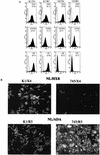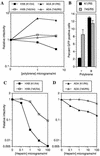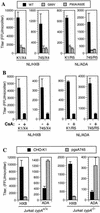Envelope-dependent, cyclophilin-independent effects of glycosaminoglycans on human immunodeficiency virus type 1 attachment and infection
- PMID: 12021366
- PMCID: PMC136233
- DOI: 10.1128/jvi.76.12.6332-6343.2002
Envelope-dependent, cyclophilin-independent effects of glycosaminoglycans on human immunodeficiency virus type 1 attachment and infection
Abstract
Cell surface glycosaminoglycans (GAGs), in particular heparan sulfate (HS), have been proposed to mediate the attachment of human immunodeficiency virus type 1 (HIV-1) to target cells prior to virus entry, and both the viral gp120 envelope protein and virion-associated cyclophilin A (CypA) have been shown to directly interact with HS and its analogues. To determine the role of GAGs in HIV attachment and infection, we generated HIV-susceptible derivatives of CHO cell lines that either express high levels of GAGs (CHO-K1) or lack GAGs (pgsA745). Using a panel of HIV-1 envelopes, we found that cell surface GAG-mediated effects on virion attachment and infection vary in an envelope strain-dependent but coreceptor-independent manner. In fact, cell surface GAG-mediated enhancement of infection is confined to isolates that contain a highly positively charged V3-loop sequence, while infection by most strains is apparently inhibited by the presence of GAGs. Moreover, the enhancing and inhibitory effects of polycations and polyanions on HIV-1 infection are largely dependent on the presence of cell surface GAGs. These observations are consistent with a model in which GAGs influence in vitro HIV-1 infection primarily by modifying the charge characteristics of the target cell surface. Finally, the effects of GAGs on HIV-1 infection are observed to an equivalent extent whether CypA is present in or absent from virions. Overall, these data exclude a major role for GAGs in mediating the attachment of many HIV-1 strains to target cells via interactions with virion-associated gp120 or CypA.
Figures







Similar articles
-
DC-SIGN and L-SIGN Are Attachment Factors That Promote Infection of Target Cells by Human Metapneumovirus in the Presence or Absence of Cellular Glycosaminoglycans.J Virol. 2016 Aug 12;90(17):7848-63. doi: 10.1128/JVI.00537-16. Print 2016 Sep 1. J Virol. 2016. PMID: 27334579 Free PMC article.
-
Respiratory syncytial virus with the fusion protein as its only viral glycoprotein is less dependent on cellular glycosaminoglycans for attachment than complete virus.Virology. 2002 Mar 15;294(2):296-304. doi: 10.1006/viro.2001.1340. Virology. 2002. PMID: 12009871
-
Gp120 stability on HIV-1 virions and Gag-Env pseudovirions is enhanced by an uncleaved Gag core.Virology. 2003 Sep 30;314(2):636-49. doi: 10.1016/s0042-6822(03)00467-7. Virology. 2003. PMID: 14554091
-
Interaction between respiratory syncytial virus and glycosaminoglycans, including heparan sulfate.Methods Mol Biol. 2007;379:15-34. doi: 10.1007/978-1-59745-393-6_2. Methods Mol Biol. 2007. PMID: 17502668 Review.
-
Glycosaminoglycans and infection.Front Biosci (Landmark Ed). 2016 Jun 1;21(6):1260-77. doi: 10.2741/4455. Front Biosci (Landmark Ed). 2016. PMID: 27100505 Free PMC article. Review.
Cited by
-
Sulfotransferase and Heparanase: Remodeling Engines in Promoting Virus Infection and Disease Development.Front Pharmacol. 2018 Nov 22;9:1315. doi: 10.3389/fphar.2018.01315. eCollection 2018. Front Pharmacol. 2018. PMID: 30555321 Free PMC article. Review.
-
Mechanism of HIV-1 virion entrapment by tetherin.PLoS Pathog. 2013;9(7):e1003483. doi: 10.1371/journal.ppat.1003483. Epub 2013 Jul 18. PLoS Pathog. 2013. PMID: 23874200 Free PMC article.
-
Evolution of cell recognition by viruses: a source of biological novelty with medical implications.Adv Virus Res. 2003;62:19-111. doi: 10.1016/s0065-3527(03)62002-6. Adv Virus Res. 2003. PMID: 14719364 Free PMC article. Review.
-
Heparan sulfate proteoglycans mediate attachment and entry of human T-cell leukemia virus type 1 virions into CD4+ T cells.J Virol. 2005 Oct;79(20):12692-702. doi: 10.1128/JVI.79.20.12692-12702.2005. J Virol. 2005. PMID: 16188972 Free PMC article.
-
Tracking and quantitation of fluorescent HIV during cell-to-cell transmission.Methods. 2011 Jan;53(1):20-6. doi: 10.1016/j.ymeth.2010.06.018. Epub 2010 Jul 11. Methods. 2011. PMID: 20627127 Free PMC article. Review.
References
-
- Baba, M., R. Snoeck, R. Pauwels, and E. de Clercq. 1988. Sulfated polysaccharides are potent and selective inhibitors of various enveloped viruses, including herpes simplex virus, cytomegalovirus, vesicular stomatitis virus, and human immunodeficiency virus. Antimicrob. Agents Chemother. 32:1742-1745. - PMC - PubMed
Publication types
MeSH terms
Substances
Grants and funding
LinkOut - more resources
Full Text Sources
Other Literature Sources

